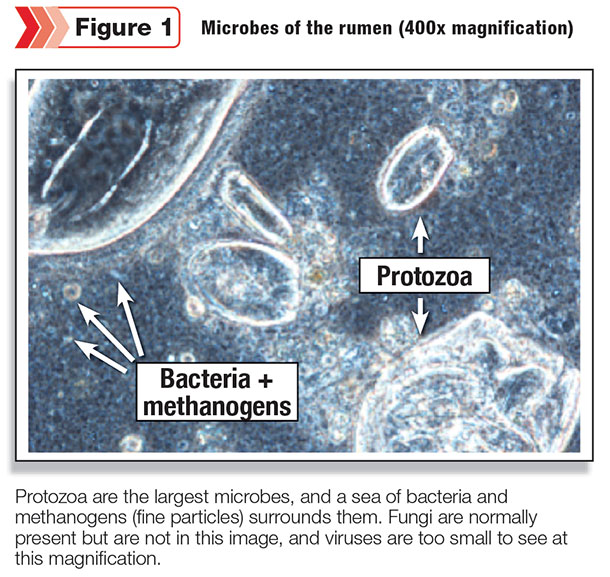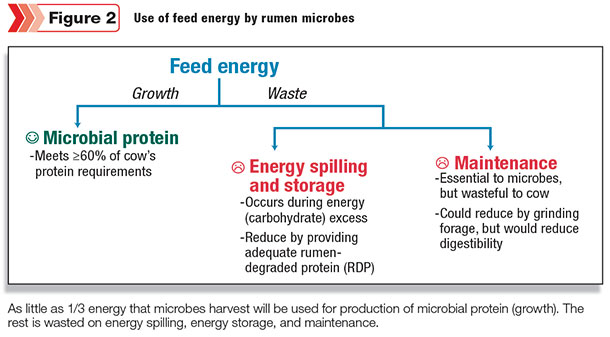The world inhabited by rumen microbes, though hidden from view, is fascinating. Dark and devoid of oxygen, the rumen may seem inhospitable to life. In reality, it is quite the opposite: Hundreds of trillions of microbes can be found in a single, 20-gallon rumen of an average cow (Figure 1). By comparison, only 100 billion people have ever lived on earth.

We are not sure how many microbial species live in the rumen, but for bacteria alone there are likely thousands. In addition to bacteria, the rumen teems with protozoa, fungi, methanogens (methane-producers) and viruses (Figure 1).
Protozoa are about the same width as a human hair, and some can even be seen by the naked eye. Other microbes are much smaller – bacteria are about one-tenth the size of a droplet of fog – and completely invisible.
Far more than a curiosity, the rumen and its microbes hold a central role in cattle feeding. Microbial fermentation stands as the very reason we can feed fiber to cattle in large quantities. During fermentation, microbes break down fiber and other feed components to volatile fatty acids (acetate, propionate, butyrate).
In this process, microbes harvest energy from feed and then harness part of this energy to produce microbial protein. Volatile fatty acids so produced meet up to 70 percent of the animal’s energy needs, and microbial protein meets 60 to 85 percent or more of protein needs.
Energy costs
Microbes may be essential to cattle, but they charge a fee for their services. Microbial metabolism causes 4 percent of feed (gross) energy to be lost as heat, and methane production from methanogens causes an additional 2 to 12 percent loss.
Feeding more grain and fat can help curtail these losses, but this practice may not always be economical. Despite extensive research efforts, few other strategies have been developed that are successful long term, and heat and methane seem to be unavoidable products of a healthy fermentation.
Even if we cannot reduce the energetic fee microbes collect, we may be able to make microbes spend those fees more efficiently.
At present, microbes are not particularly efficient with the energy they harvest from fermentation; they may use as little as one-third for production of microbial protein (cellular growth).
As explained below, the remaining (two-thirds) energy is “wasted” on functions other than protein production (energy spilling, energy storage, maintenance of cells) (Figure 2). If we could re-route even part of this wasted energy, we could increase microbial protein and decrease need for expensive feed protein.

Avoiding energy excess
Just as a college student overspends the allowance he just received from his parents, microbes tend to waste more during times of excess. In fact, when given large excess of carbohydrate (usually from grain), rumen microbes may simply burn off the excess energy as heat, in a process known as energy spilling (Figure 2).
When given smaller excesses of carbohydrate, microbes can store much of the energy (Figure 2), but storage itself requires an irreversible expenditure of energy. (Unfortunately, humans are better at storing energy than spilling it. Otherwise, holiday feasts would be less worrisome.)
Proper ration formulation is needed to avoid carbohydrate excess and thus reduce waste through spilling and storage.
Carbohydrate excess occurs when rumen-degraded protein (RDP) is low, thereby limiting production of microbial protein. According to the Dairy NRC, RDP requirements fall between 9.5 to 11.3 percent of diet dry matter for lactating cattle and 8.6 to 10.8 percent for heifers.
A shortfall of RDP arises most commonly for feedlot-type rations with high inclusion of grain, but it can still occur in dairy rations with corn silage as the sole source of forage.
If ration formulation software or a nutritionist indicates such a shortfall, increase inclusion of high-RDP ingredients (such as soybean meal and urea). Alternatively, decrease carbohydrate by substituting it with fat (which is energy-rich but cannot be fermented).
Eliminating wasteful microbes
Just as some college students spend allowances more responsibly than others, some microbes may be inherently more wasteful than others. One microbe that has drawn attention is the bacterium Streptococcus bovis. It was first recognized for causing acidosis.
When cattle are abruptly switched from high-forage to high-grain diets, Streptococcus bovis feasts on the abundant carbohydrate (starch and sugars) available in the rumen. If left unchecked, it can hijack the rumen by rapidly fermenting carbohydrate to lactate and decreasing rumen pH to 4.5 or lower, in which few microbes can survive. The result is acute rumen acidosis, which can be lethal.
Although infamous for causing acidosis, Streptococcus bovis is also conspicuously wasteful. When feasting on carbohydrate, it has a propensity to take up excess and spill energy. Although it proliferates best under the abrupt switch to grain as mentioned, it is still present in low abundance for all diets, even high-forage ones.
A few strategies may exist for reducing Streptococcus bovis. Some conventional antibiotics, such as virginiamycin, decrease Streptococcus bovis more than tenfold. However, they kill other rumen bacteria, and their net effect on energy waste remains unknown.
Live yeast (Saccharomyces cerevisiae) competes with Streptococcus bovis for carbohydrate, at least in the laboratory. However, how extensively competition really occurs in the rumen is still unclear, much less whether yeast would use carbohydrate energy less wastefully than Streptococcus bovis.
Other strategies, still experimental, involve administering antibodies, which bind to and inhibit bacteria; vaccines, which stimulate production of antibodies; viruses, which infect and kill bacteria; and bacteriocins, which are antibiotic-like compounds produced naturally by rumen bacteria.
Antibodies and vaccines successfully reduced Streptococcus bovis in animal trials. Viruses and bacteriocins have been effective in the lab, but success in animal trials is yet to be firmly demonstrated.
Streptococcus bovis is unlikely to be the only wasteful microbe. We have observed that populations of rumen microbes can waste (spill) energy even when lactate is not produced.
Because lactate production is a fingerprint of energy spilling by Streptococcus bovis, other microbes must be responsible for this waste. Research is under way to identify those wasteful microbes, and strategies to eliminate these microbes could then follow.
Unavoidable waste
Even with the strategies outlined above, waste cannot be eliminated entirely. Microbes need to expend some energy to maintain their cells in order to stay alive (Figure 2).
This maintenance expenditure is a biological necessity to microbes, but it is still wasteful from the cow’s perspective because this energy does not lead to production of microbial protein (only heat). Increasing passage rate, such as by grinding forage, would decrease the proportion of energy expended on maintenance, but it also decreases digestibility of fiber and so may not be a practical strategy.
Summary
Some waste can be reduced by including sufficient dietary RDP to avoid energy excesses. In the future, we may be able to directly manipulate microbial populations – such as with bacteriocins, viruses or vaccines – to eliminate the most wasteful microbes. PD
Timothy Hackmann is an assistant professor of gastrointestinal microbiology with the University of Florida. He can be contacted by email.
References omitted due to space but are available upon request. Click here to email an editor.





